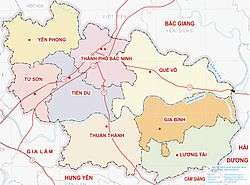Gia Bình District
| Gia Binh District Huyện Gia Bình | |
|---|---|
| Rural district | |
 | |
| Country |
|
| Region | Red River Delta |
| Province | Bắc Ninh |
| Capital | Gia Bình |
| Area | |
| • Total | 42 sq mi (108 km2) |
| Population (2003) | |
| • Total | 102,753 |
| Time zone | UTC+7 (UTC + 7) |
Gia Bình is a rural district of Bắc Ninh Province in the Red River Delta region of Vietnam.
History
The district was originally called Gia Định (Hán: 嘉定) district, but since this caused it to be confused with Thành Gia Định, the name of Saigon at the time, Nguyen dynasty officials changed the name to Gia Bình district in 1820.[1]
In August 5, 1472, the second king of the Post-Le dynasty, Lê Thái Tông was pass away at the age of 20, at Lệ Chi Garden (which is nowadays belongs to Đại Lai commune, a part of Gia Binh district). Nguyễn Trãi and his wife, Nguyễn Thị Lộ, were accused of the King murder sentence, which resulted in death of Nguyễn Trãi relatives (including his father's relatives, his mother's and his wife's relatives) Le Chi Vien
In 1950, Gia Bình was united with Lương Tài to form Gia Lương district which, however, was separated in August 9, 1999.
Today
As of 2003 the district had a population of 102,753.[2] The district covers an area of 108 km². The district capital lies at Gia Bình.[2] The district has an area of 107,9 km2 and a population of 103,100 (2006). Gia Bình is administratively divided into 15 subdivisions: one township (thị trấn) and 14 communes (xã) including Quang Ái village,[3] Hưng Triệu village,[4]
Economy
Gia Bình is well known for some products with the famous Dai Bai Bronze and Xuan Lai Bamboo etc.
Climate
Gia Binh district features a warm humid subtropical climate with plentiful precipitation. The annual average temperature is 24 °C in Gia Binh region. The highest is 30 °C in July; the lowest is 15 °C in January. The average annual sunshine is 1,530-1,776 hours, relative humidity is 79%. The district experiences the typical climate of northern Vietnam, where summers are hot and humid, and winters are, by national standards, relatively cold and dry. Summers, lasting from May to September, are hot and humid, receiving the majority of the annual 1,680 millimetres (66.1 in) of rainfall. The winters, lasting from November to March, are relatively mild, while spring in April can bring light rains. Autumn in October is the best time of the year in terms of weather.
References
- ↑ Choi Byung Wook Southern Vietnam Under the Reign of Minh Mạng (1820-1841) 0877271380 2004 p20 "Because the name of the Gia Dinh district caused it to be confused with Gia Dinh Thanh, in 1820 the central government changed the name of the Gia Dinh district to the Gia Binh district. See Phan Thiic Truc, Quoc Su Di Bien (A transmitted ..."
- 1 2 "Districts of Vietnam". Statoids. Retrieved March 13, 2009.
- ↑ Monica Janowski, Fiona Kerlogue Kinship And Food in South East Asia - 2007 p244 "For example, in Quang Ái village (Gia Bình district, Bác Ninh province) all villagers had the family name Dinh; in thirty other villages, all residents belonged to the same patrilineal clan Nguyên (Gourou [1936] 1965: 125, 127)."
- ↑ Văn Đào Hoàng Viet Nam Quoc Dan Dang: A Contemporary History 2008 p160 Đào Nguyên Huân was born in Hưng Triệu village, Gia Bình district, Bắc Ninh
Coordinates: 21°03′14″N 106°10′41″E / 21.05389°N 106.17806°E

